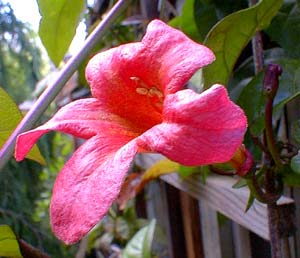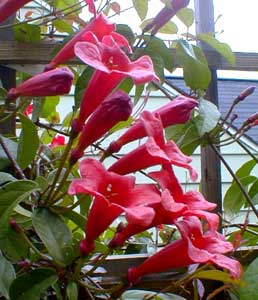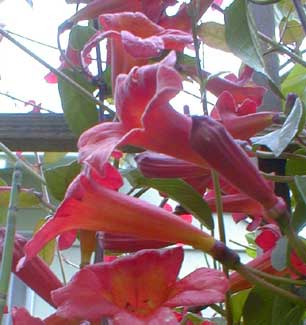
'Dragon Lady' Crossvine,
or Trumpet Flower,
or Trumpet Creeper
"The throats of the little red trumpet-flowers are wide open,
And the clangor of brass beats against the hot sunlight."
-Amy Lowell
(1874-1925)
(1874-1925)
Our 'Dragon Lady' Trumpet Creeper, or Crossvine, or Bignonia is a cultivar of Bignonia capreolata. We obtained it when it was quite small & for three years it developed very slowly on a semi-shaded trellis.
Though it is shade tolerant in warmer zones, it might've preferred full sun here on Puget Sound in order to develop faster. It did not have a great deal of sun until it reached the top of the eight-foot trellis, & it does most of its blooming up in the sun. By its fifth year (in 2004) it began to spread along the neighbor's side of the fence which gets direct sunlight.
 I saw one photo of a very old crossvine, decades old, it had a veritable tree-trunk to it, & had climbed to seventy feet to the top of a tree. Cultivars like 'Dragon Lady' are never so large. When we first obtained this vine, we could find nothing on the specific cultivar as it was offered for sale almost nowhere & a websearch found only a name-listing without specific information. But in 2003 this cultivar was given the Pennsylvania Horticultural Society's Gold Medal Award, & soon thereafter it became quite widely available.
I saw one photo of a very old crossvine, decades old, it had a veritable tree-trunk to it, & had climbed to seventy feet to the top of a tree. Cultivars like 'Dragon Lady' are never so large. When we first obtained this vine, we could find nothing on the specific cultivar as it was offered for sale almost nowhere & a websearch found only a name-listing without specific information. But in 2003 this cultivar was given the Pennsylvania Horticultural Society's Gold Medal Award, & soon thereafter it became quite widely available.Various plant guides & individuals warn that the species, after its first few years of getting established, is capable of becoming very aggressive, & potentially a nuisance sending underground rhizomes considerable distances & popping up where it isn't wanted. Ours hasn't become a nuisance thus far, & I believe we may expect continued restraint from this specific cultivar, especially in our zone.
The very similar Trumpet Vines of the Campsis genus are much more apt to become a problem when grown in our zone, & I suspect Bignonia gets blamed for Campsis behavior. I could become disabused of this belief in the future if our Bignonia begins popping up all over the place. If it does become aggressive someday, I think the pruning sheers can deal with it.
 Crossvine is native to the southeastern United States, very common in East Texas. Though our winters are mild, so are our summers; it has seemed to me this vine either just slightly dislikes the cold season or what is probably more the case, isn't convinced our summers are long enough or hot enough, resulting in its restrained behavior compared to aggressive growth in the south.
Crossvine is native to the southeastern United States, very common in East Texas. Though our winters are mild, so are our summers; it has seemed to me this vine either just slightly dislikes the cold season or what is probably more the case, isn't convinced our summers are long enough or hot enough, resulting in its restrained behavior compared to aggressive growth in the south.The vines are self-clinging by little tendrils & can be trained up a wooden fence with scarcely any trellis. Ours has been started on a tall trellis attached to a six-foot wooden fence, with the idea that it should fill up the trellis then spread along the fence without further support.
It can allegedly spread twenty feet in two directions for a whopping 40 foot spread, but thus far (in six years) it has mostly restricted itself to filling up the trellis, only occasionally forcing me to trim a long vine out of nearby shrubs.
It attempts to cross the ground too, for it is alternatively a groundcover, but I always lift the trailing bits up so they climb the fence. In our zone the vines have been semi-evergreen, with bronzy-purple winter coloration. In warmer zones they are more fully evergreen.
Adaptable to a wide range of gardening conditions, 'Dragon Lady' in particular is both drought & damp tolerant & is hardy farther north than is the wild species.
We were promised "red trumpet flowers in spring" on the tag, & it does bloom best May through June, though in our garden it has rebloomed each autumn too.
Butterflies & hummingbirds love 'Dragon Lady's' orange-tinged ruby trumpets. The nectar-rich blossoms can be a bother if planted on a porch area or walkway where fallen gummy blooms accumulate, but along a fence, so that trumpets fall on soil, this is no problem.